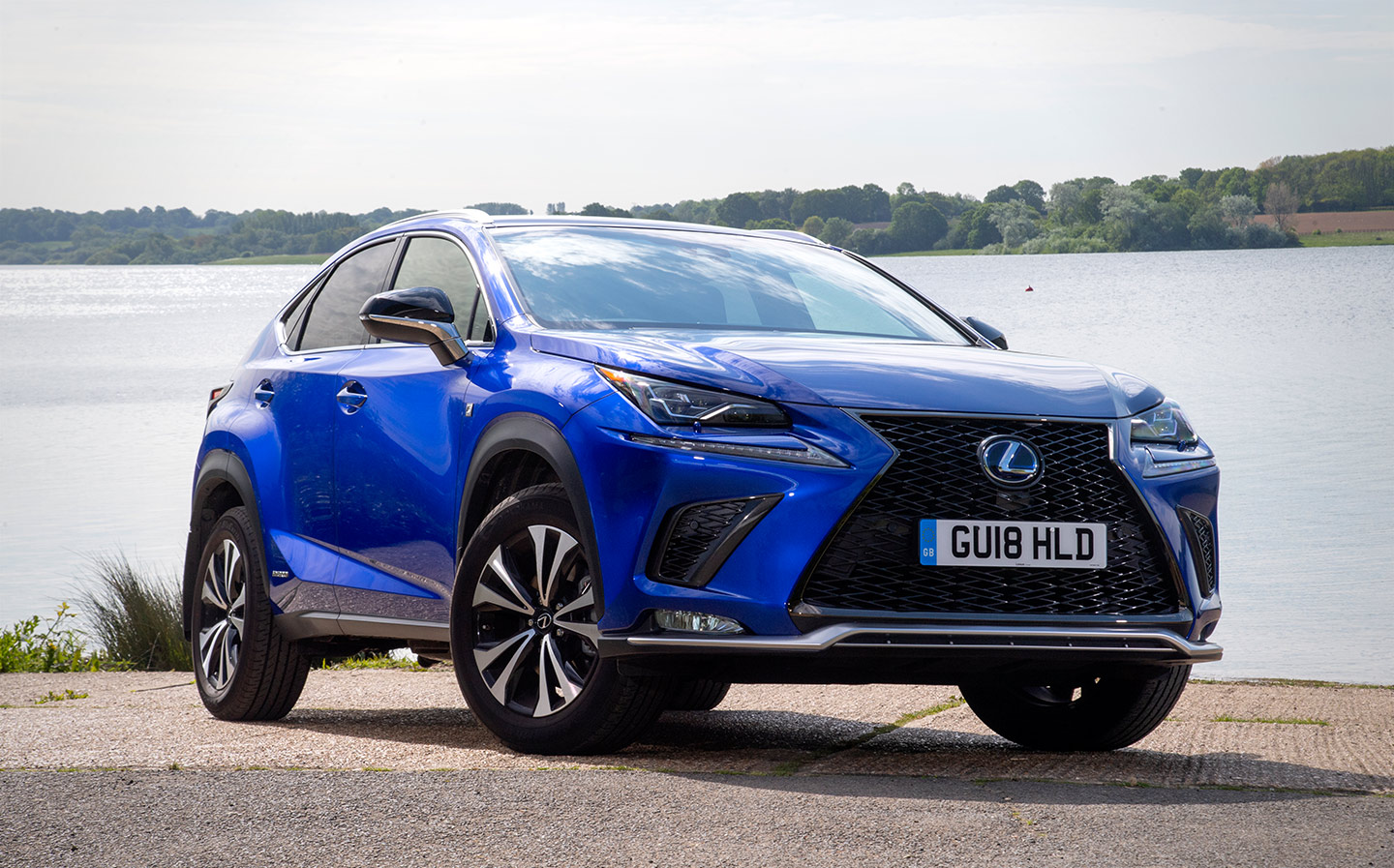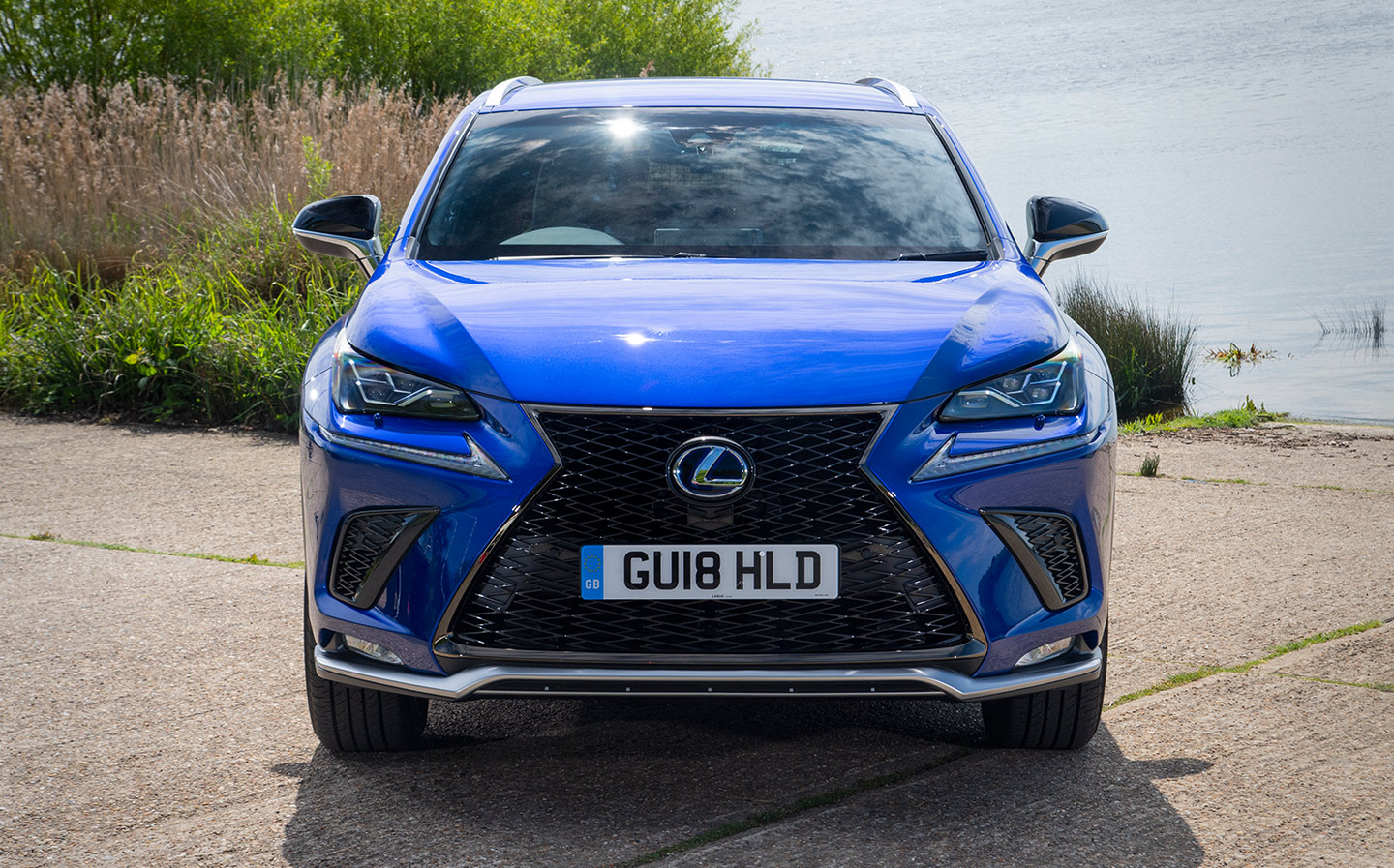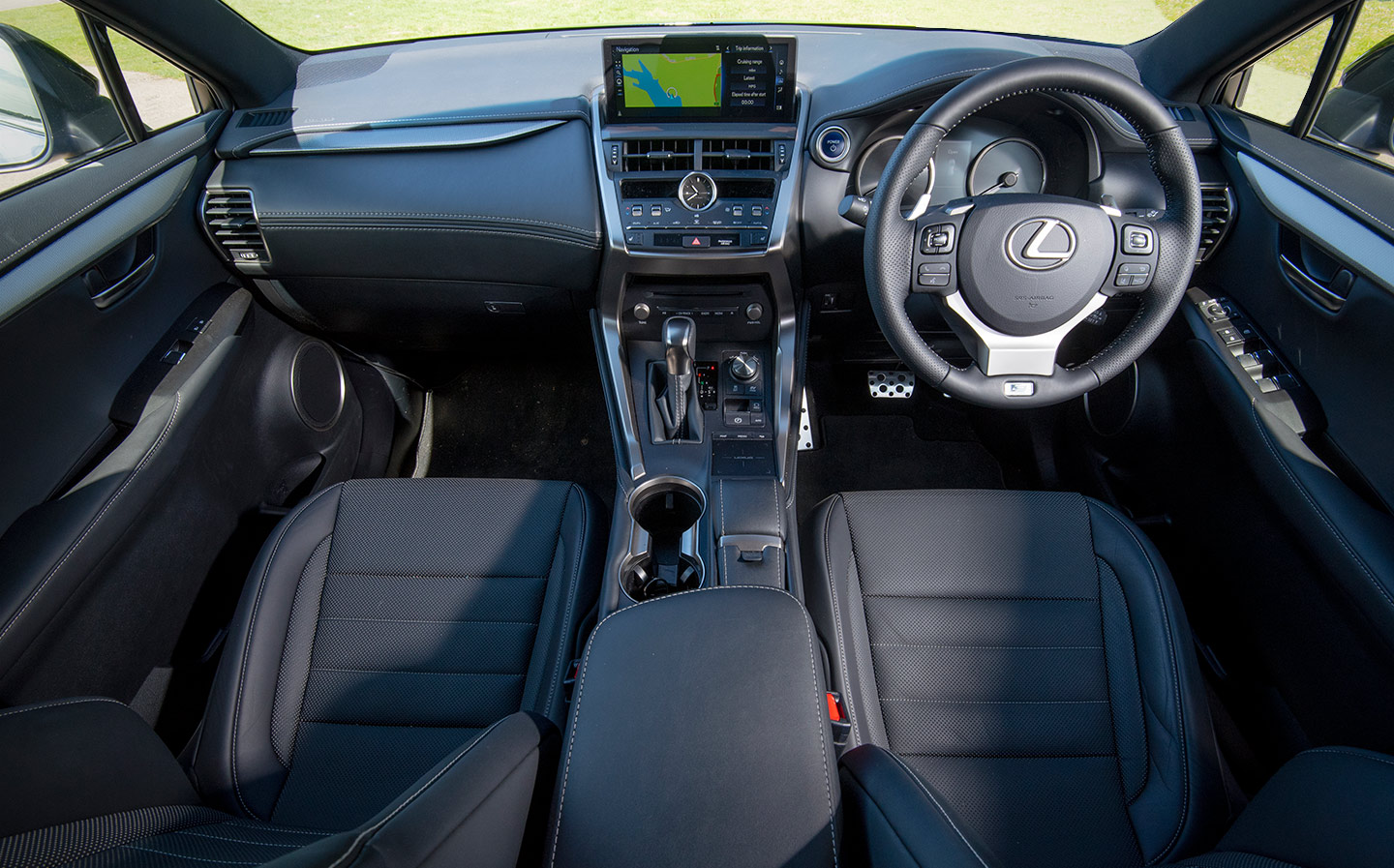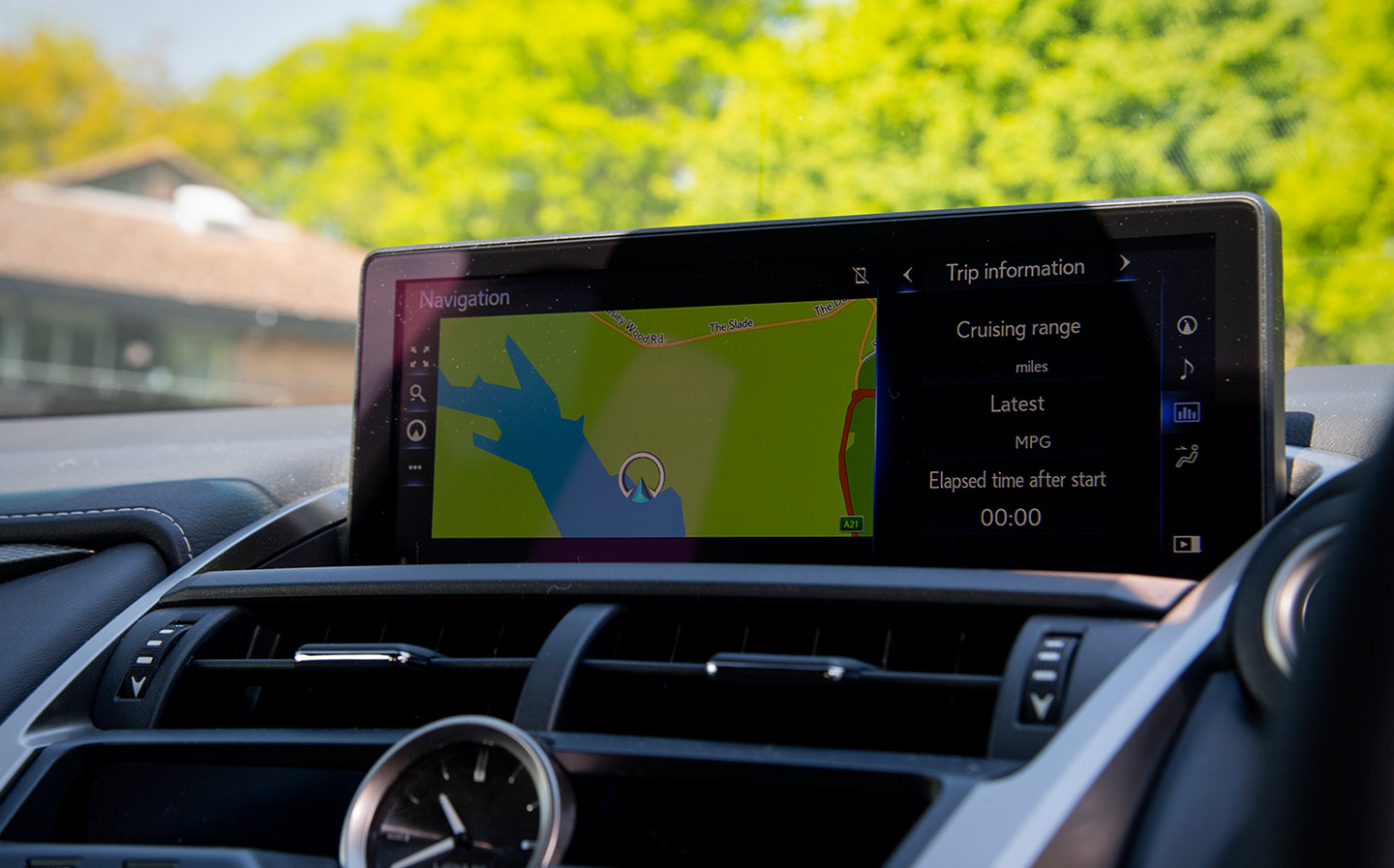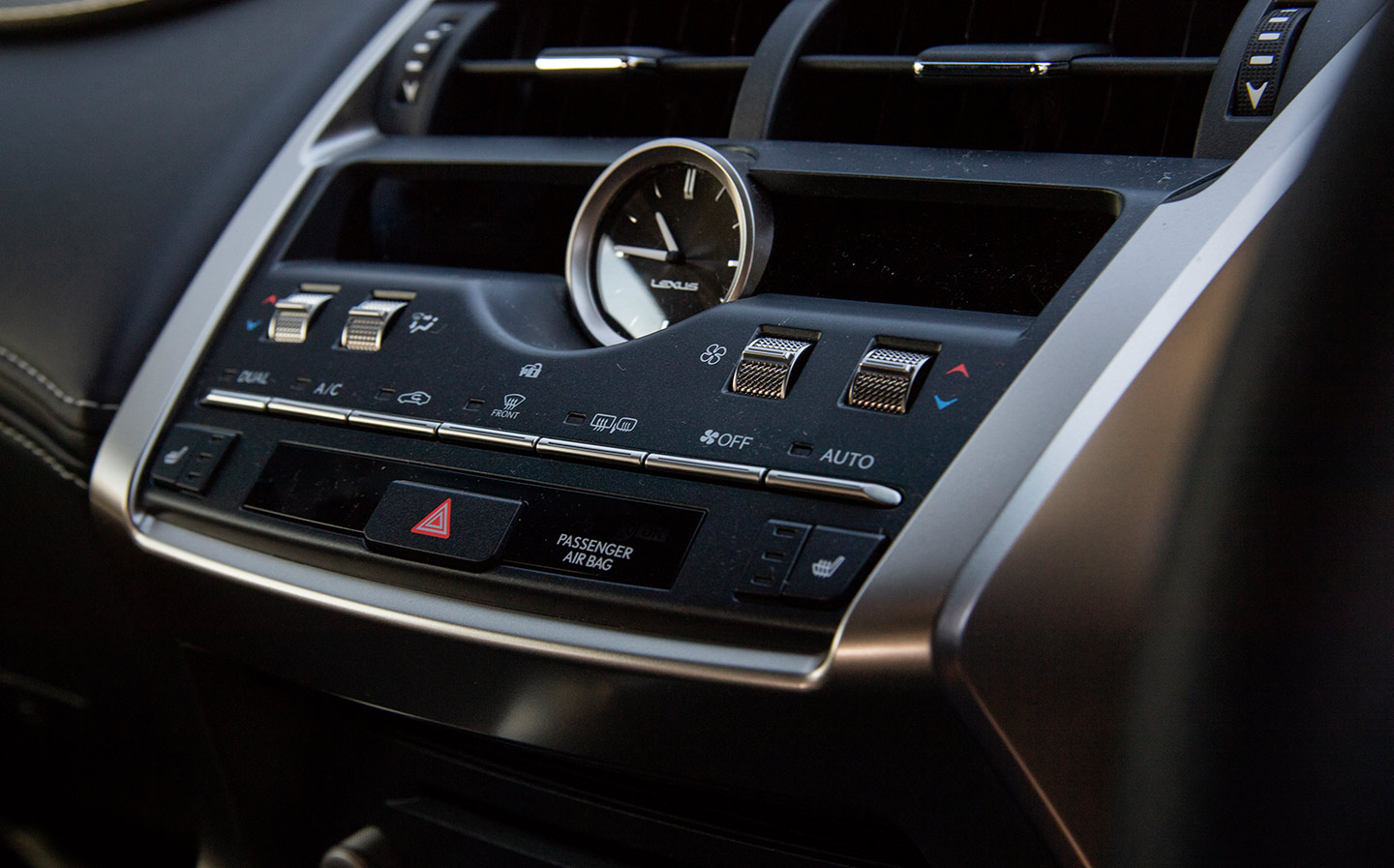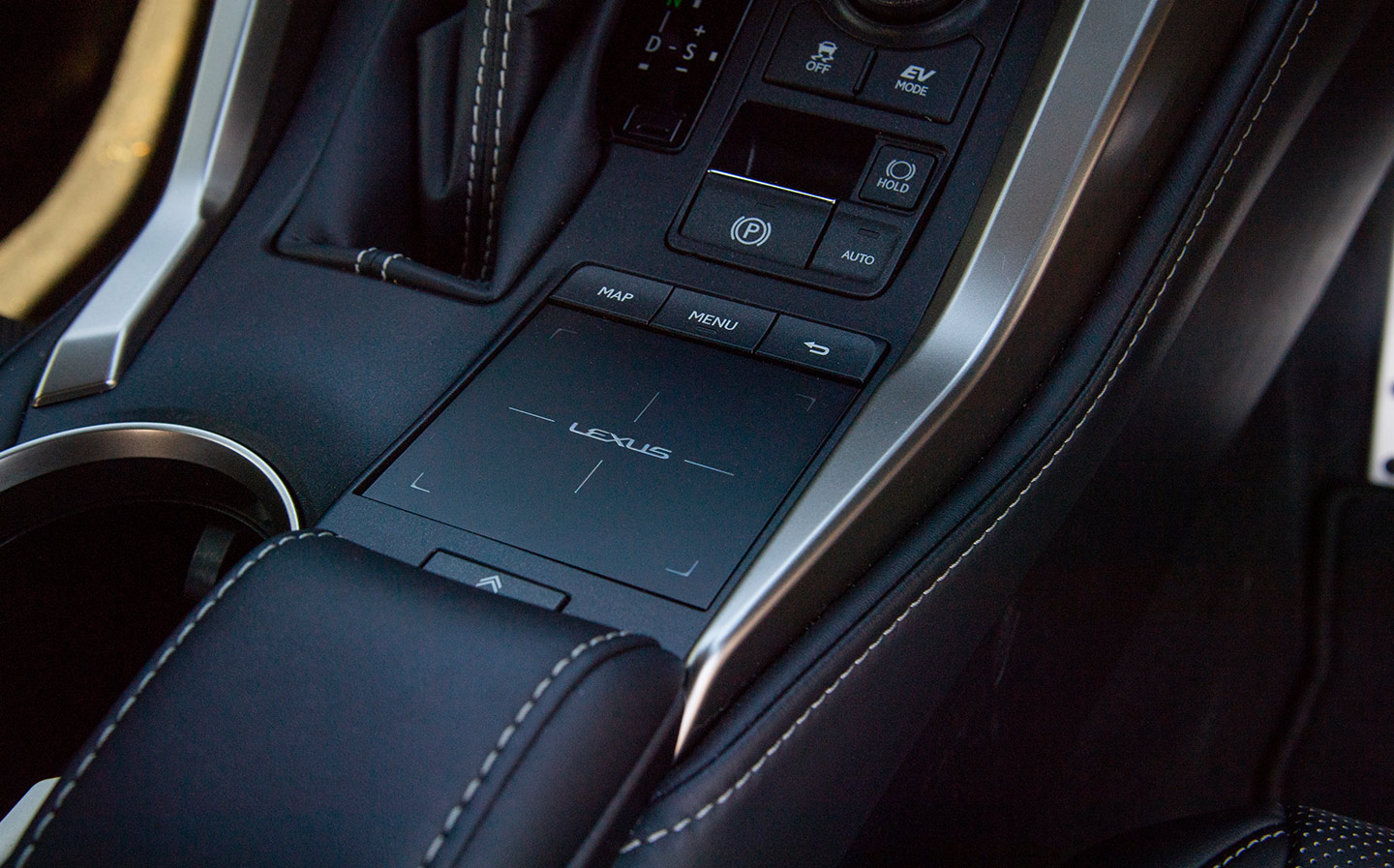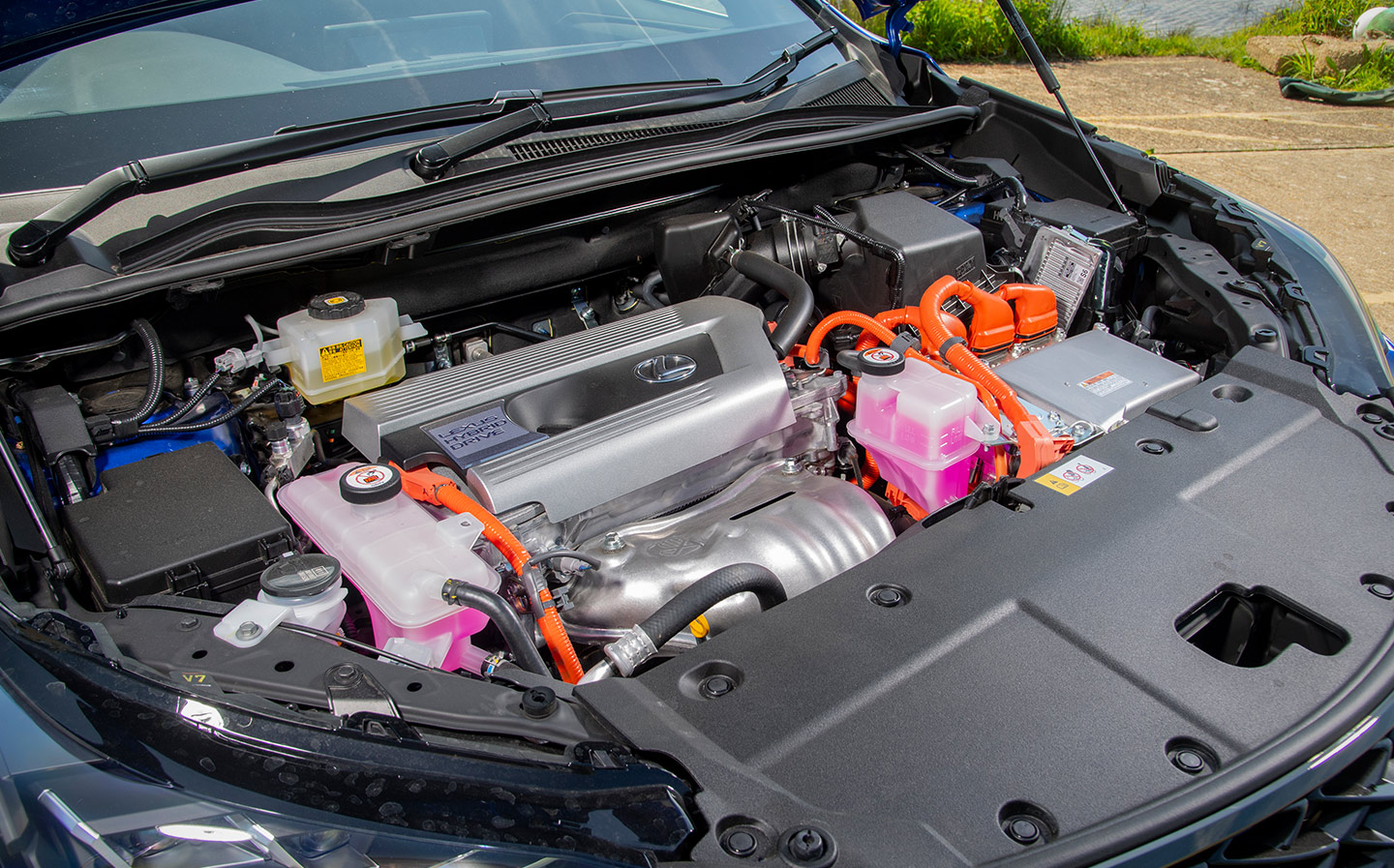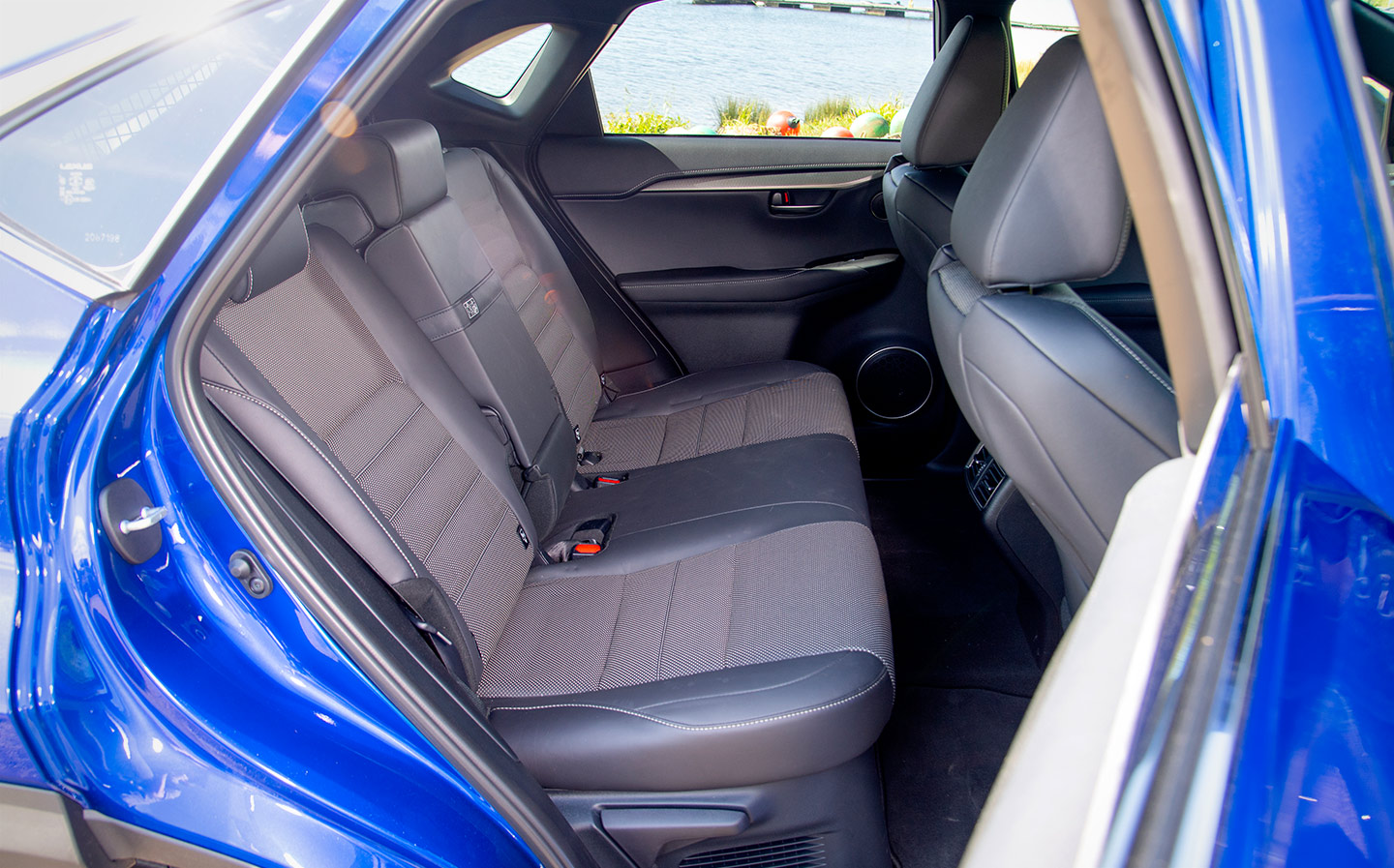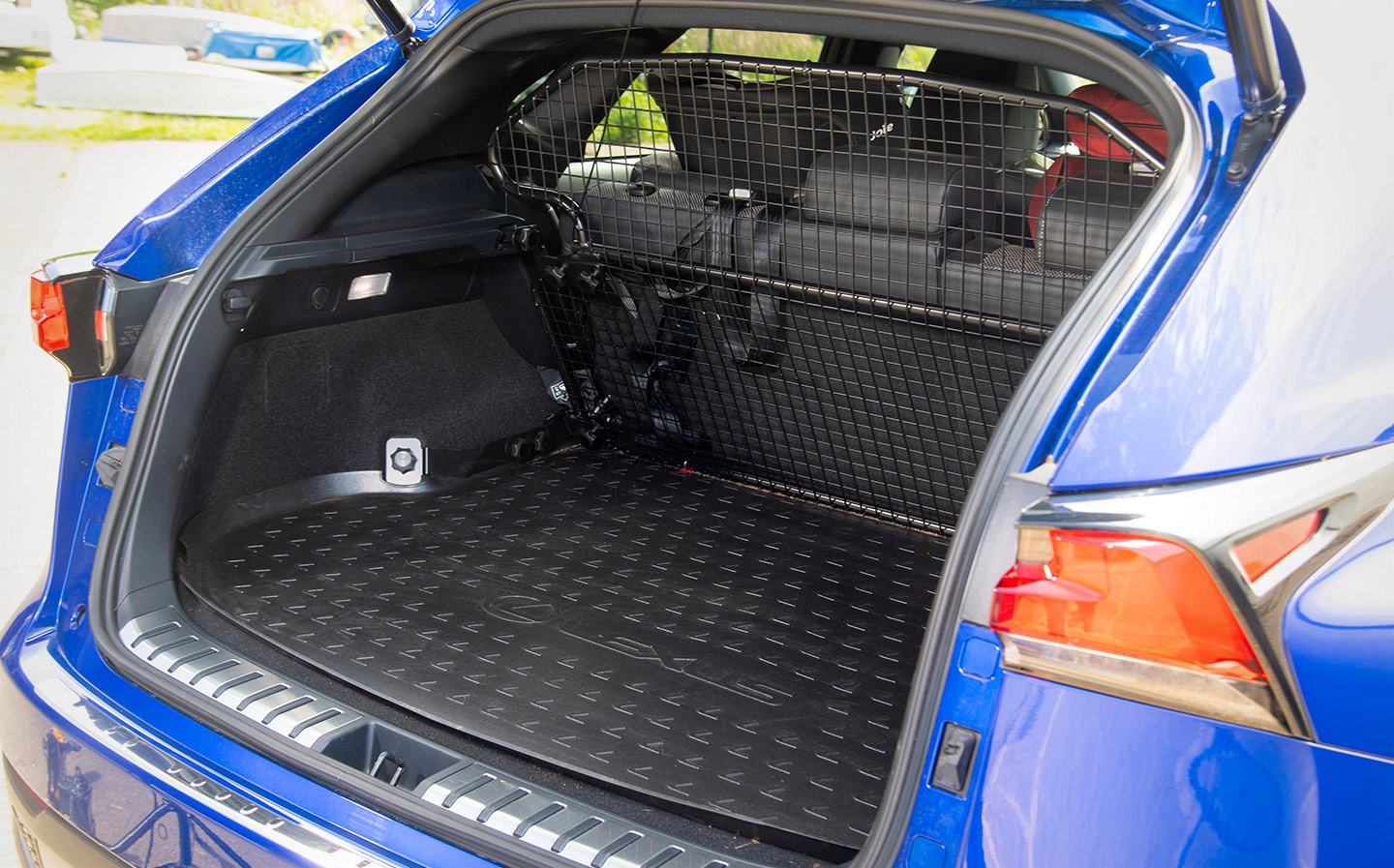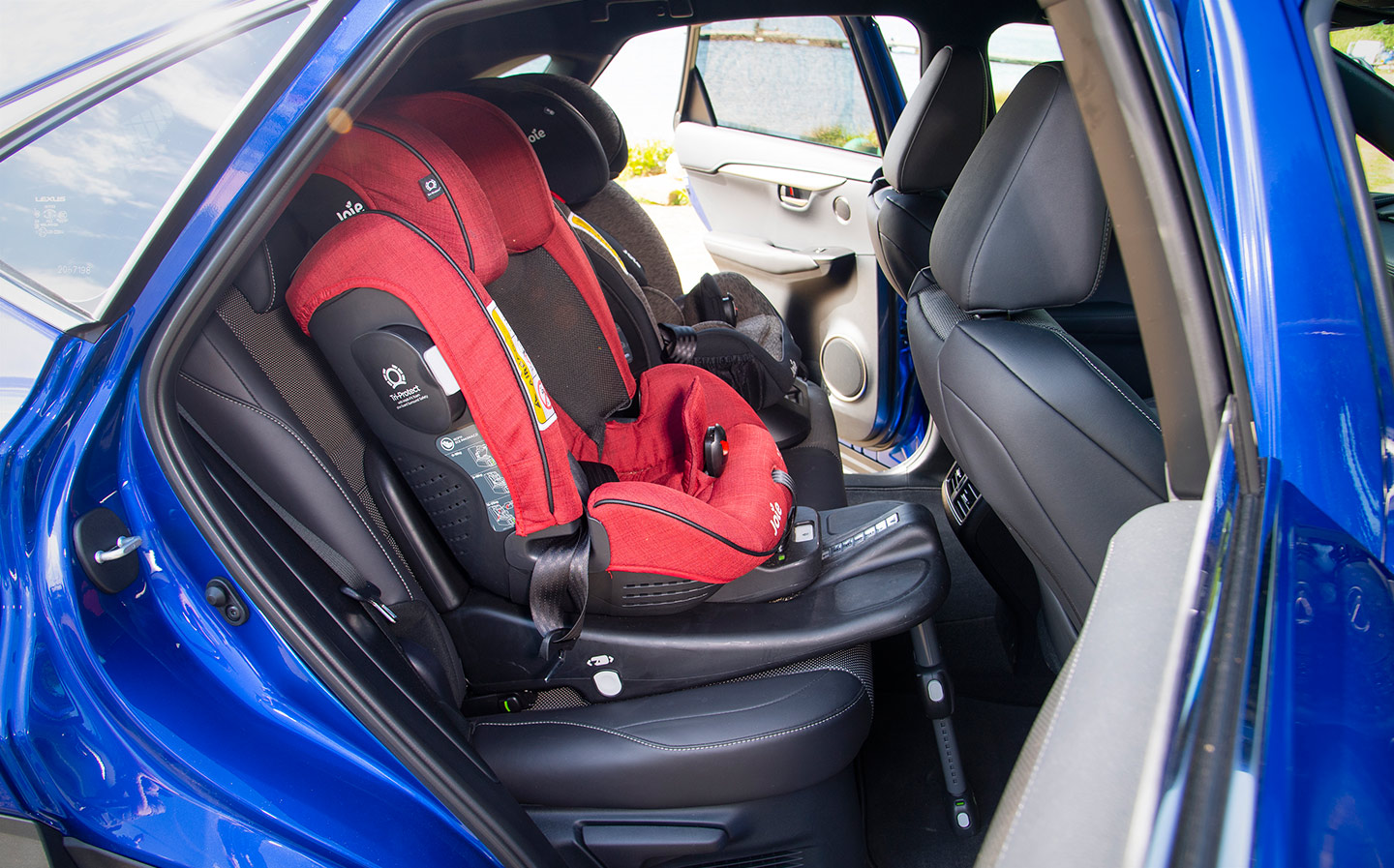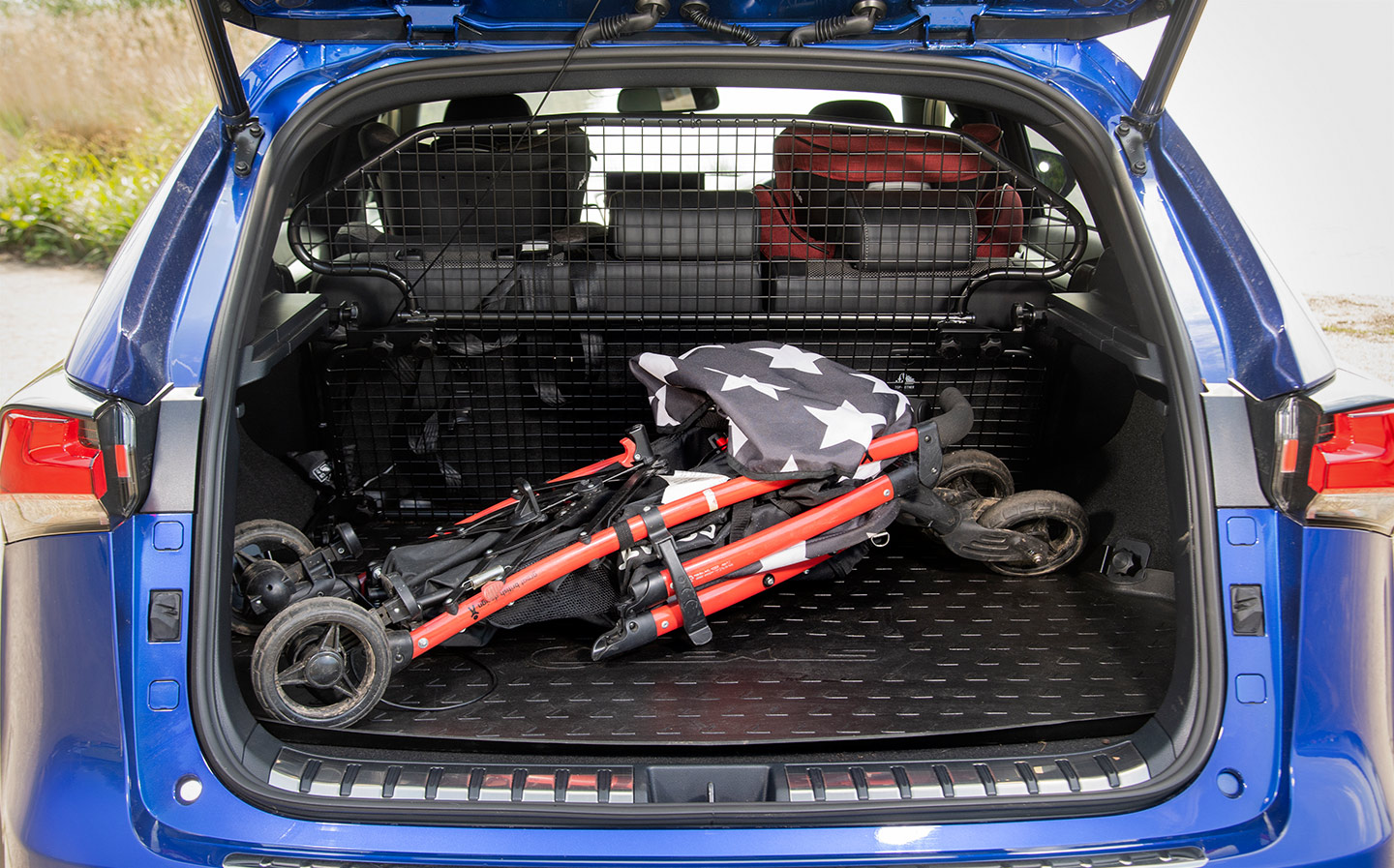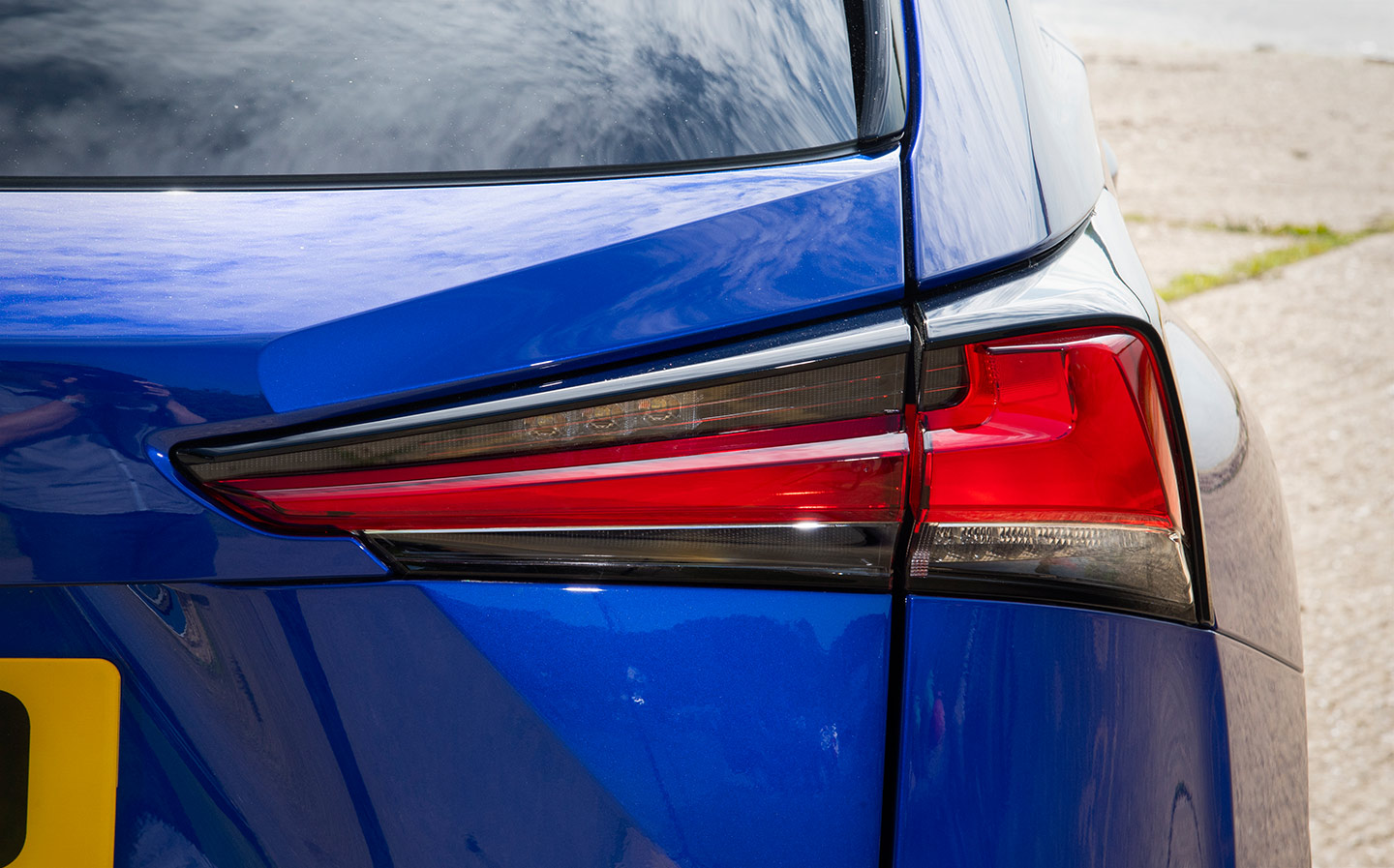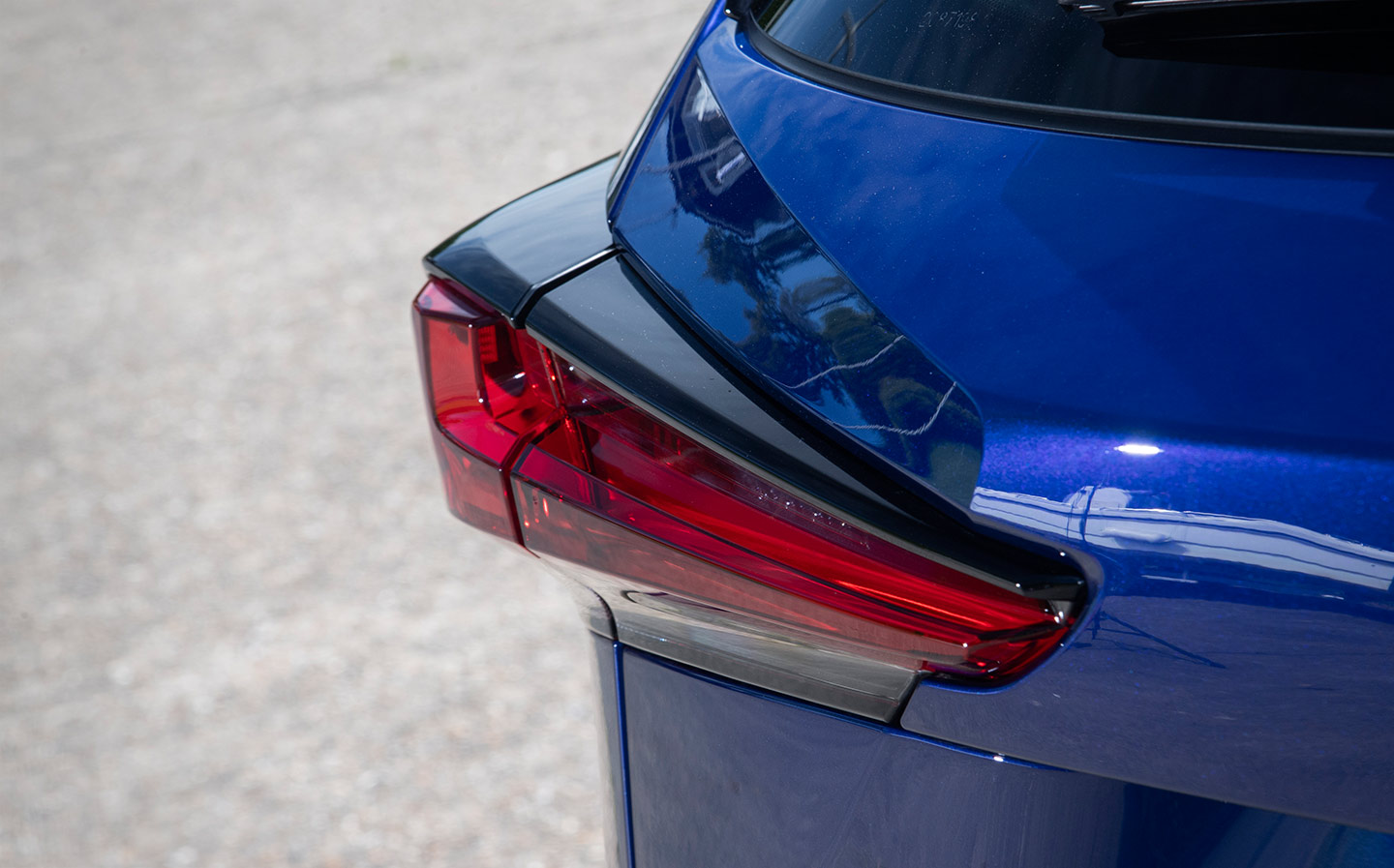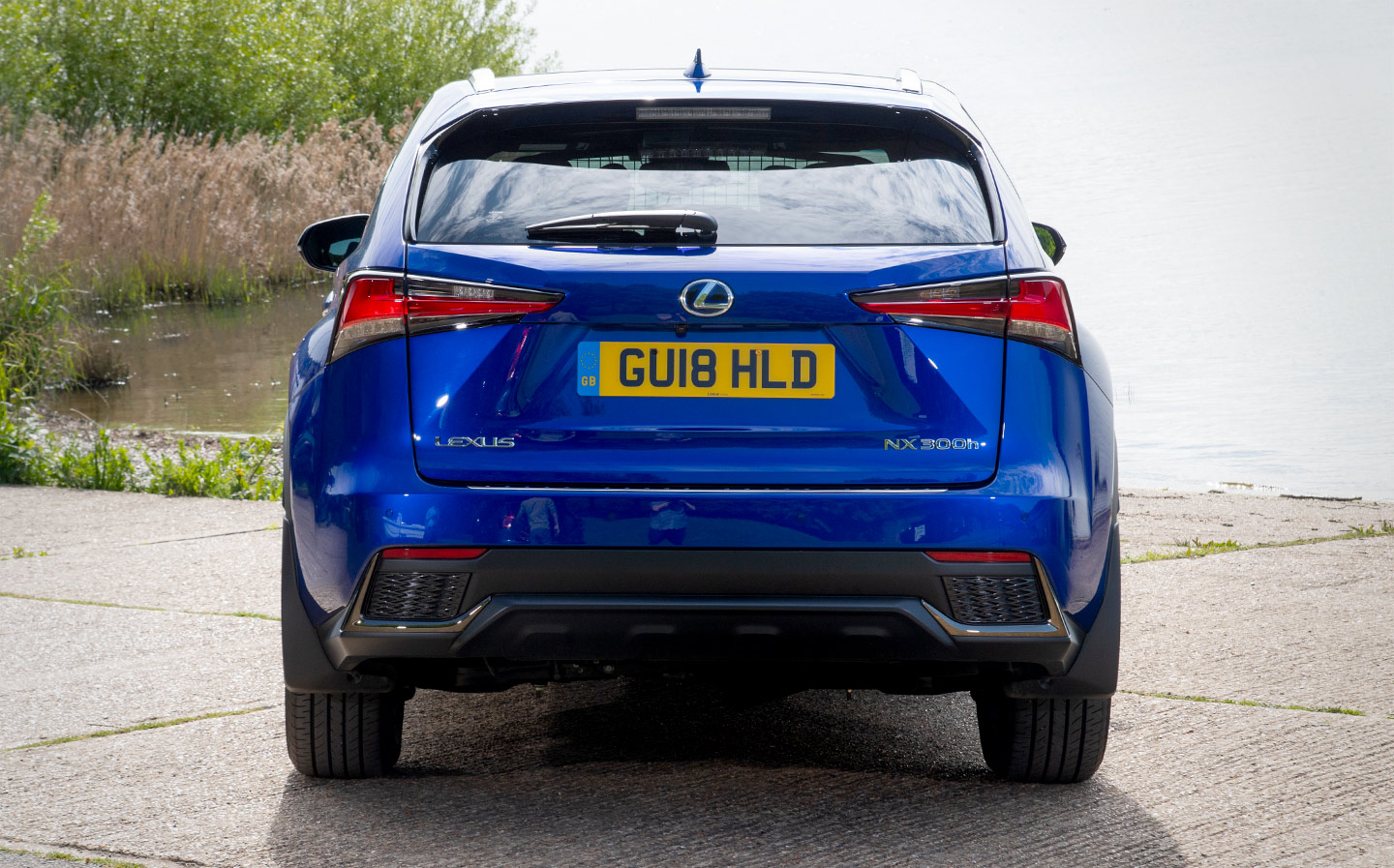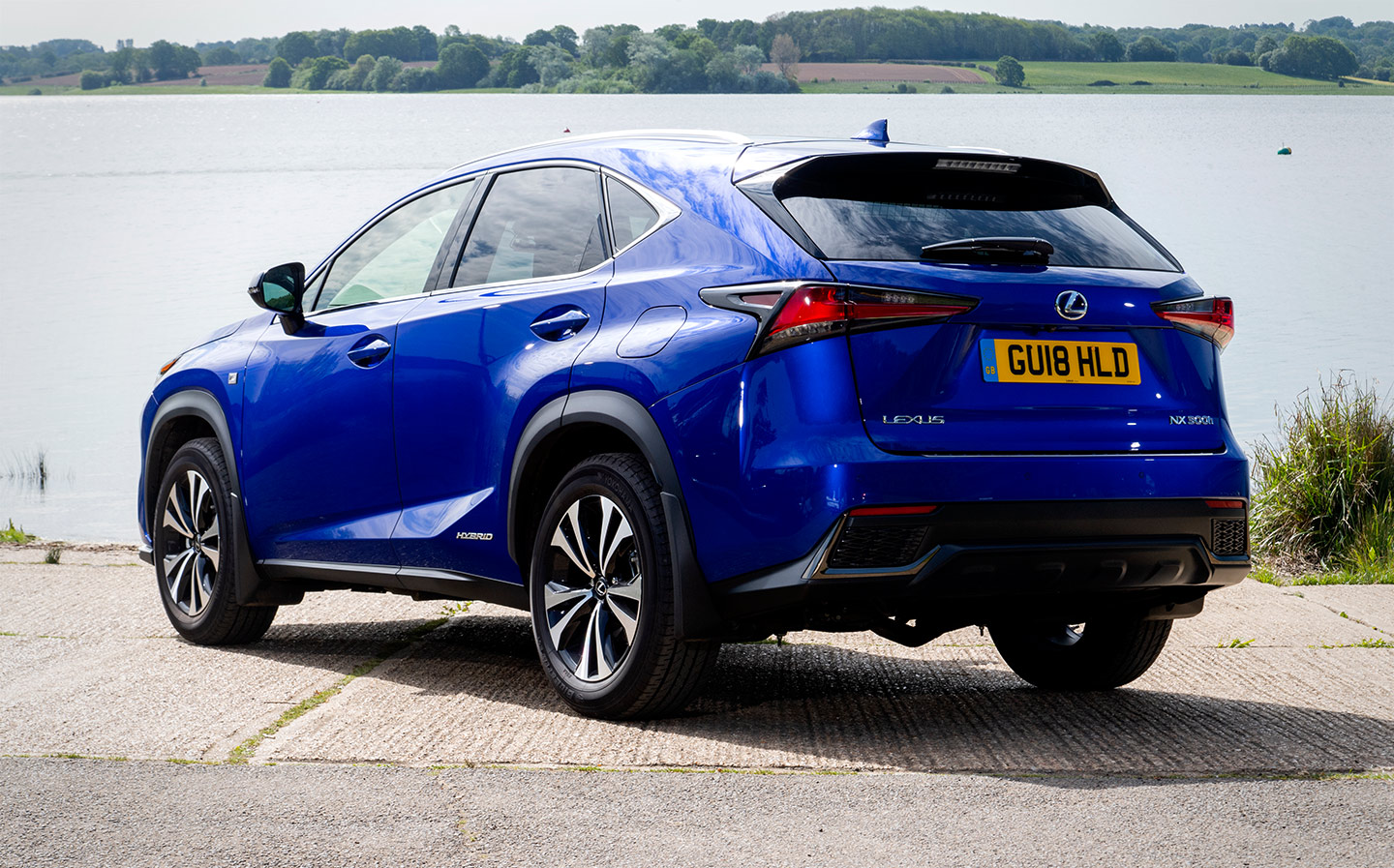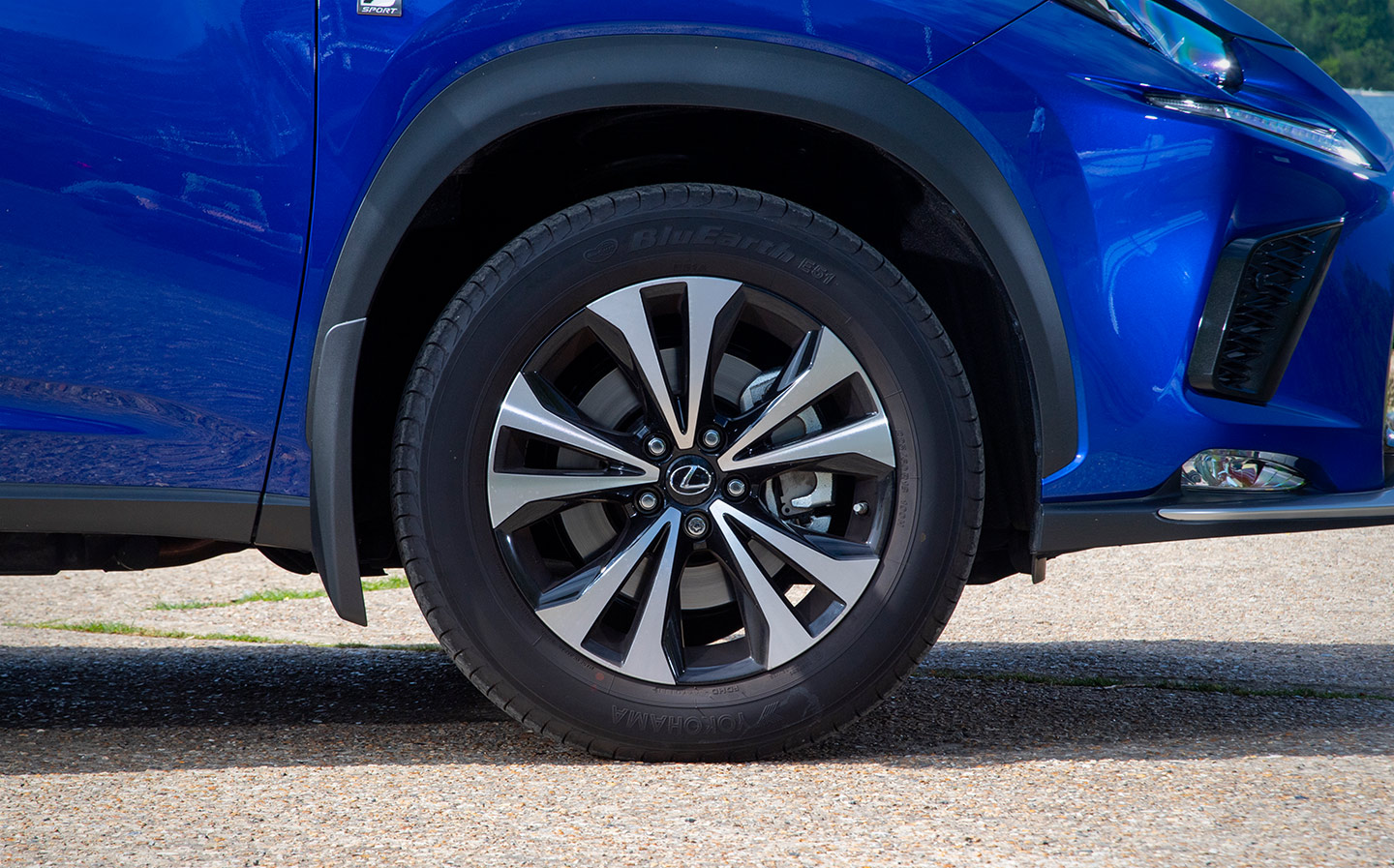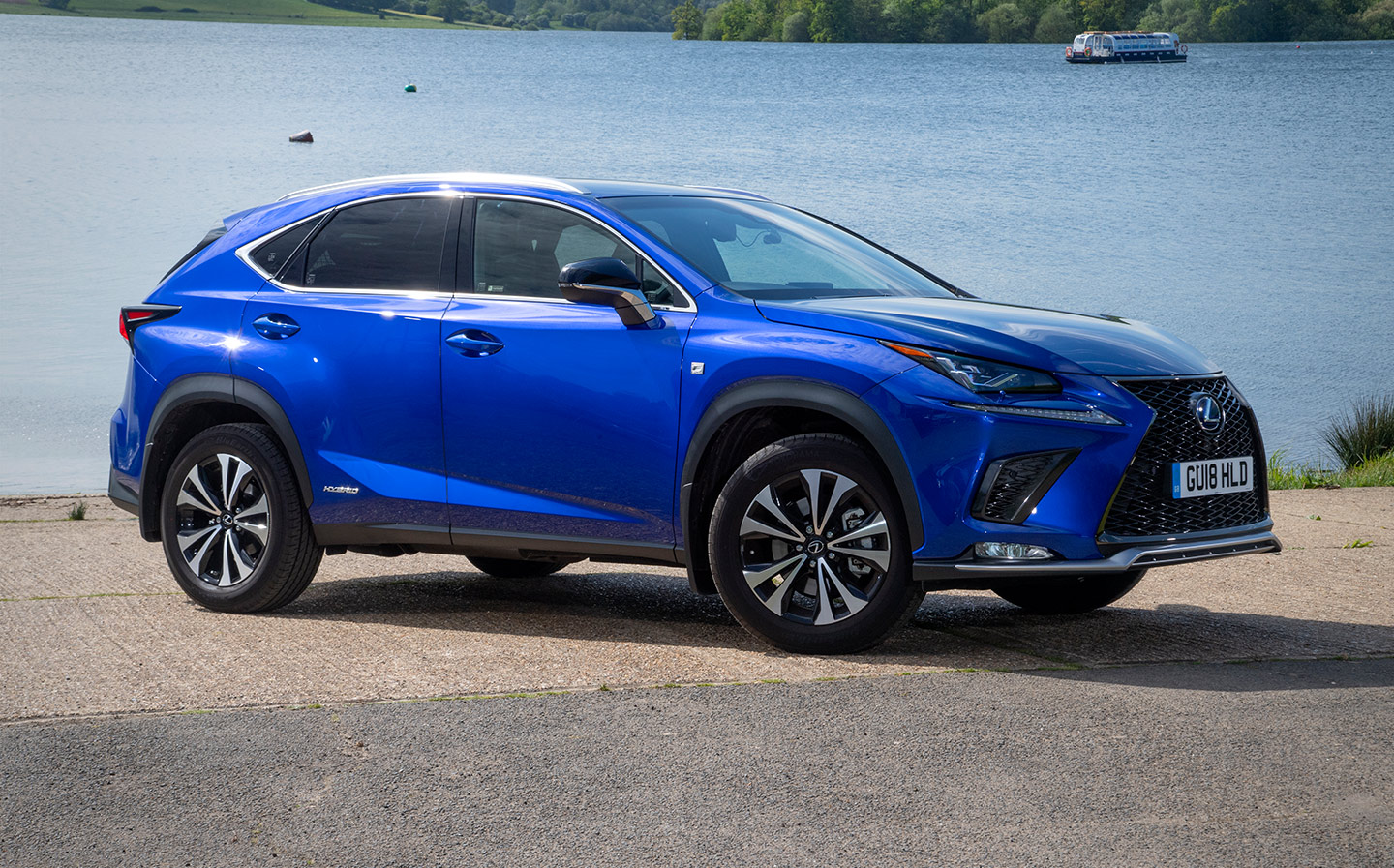Extended Test: 2018 Lexus NX 300h review
Life with Lexus's hybrid crossover
Specifications
- Model 2018 Lexus NX300h F-Sport P Navi
- Motor 2,494cc four-cylinder petrol
- Power (engine) 153bhp @ 5,700rpm
- Power (electric motor) 141bhp
- Power (max. combined) 195bhp
- Torque (max. combined) 152 lb ft
- Kerb weight 1,785kg
- Towing capacity 1,500kg (braked) / 750 (unbraked)
- Top speed 112mph
- 0-62mph 9.2sec
- Fuel consumption (NEDC lab test) 54.3mpg (combined)
- CO2 emissions 121g/km
- Road tax £155 for first year; £440 for years 2-6 (attracts £310 charge for cars over £40,000); £130 thereafter
- BIK tax (24mths, 20,000 miles) 25%; £1,989 (20%) or £3,979 (40%)
- Insurance group 32E
- Price F-Sport from £39,995 OTR
- Price with options £41,360 OTR
- Options fitted Azure Blue paint (£645); Protection Pack (£400); Trunk guard (£320)
Test details
- Test period April – October, 2018
- Starting mileage 583 miles
Updates
- June 1, 2018 Introduction to the Lexus NX & driving impressions
- June 14, 2018 Windscreen replacement, MPG update and transporting a dishwasher
- July 25, 2018 Options, options: What’s the perfect NX spec?
- August 17, 2018: Cheating on the NX
- September 28, 2018: Forget the sat nav
- November 2, 2018: Final report – The good and the bad (forget the ugly)
June 1, 2018: Introduction to the Lexus NX

Well played, Lexus. It — and parent brand Toyota, of course — saw the benefits of petrol-electric hybrid cars and ploughed on with the technology when many car enthusiasts and writers were unrelenting in expressing the view that they are dull and unrewarding to drive.
And now look: diesel sales are plummeting due to negative press over the nasty nitrogen oxide gases they can pump out, and conventional petrol cars are doomed, too. By 2040, no new cars sold in the UK will be allowed to be powered solely by petrol or diesel; they must all be at least hybrid. Lexus has permission to enter “Smug Mode”, as Red Dwarf’s mechanoid Kryten might say.
If you’re reading this because you’re under the impression that you need to switch to hybrid as soon as possible, though, think again. That 2040 date is a long way off — seven new cars away for some drivers, according to the boss of the Society of Motor Manufacturers and Traders.
“Having one sat on your driveway indicates that you’re not at all interested in following the pack”
And punitive measures such as toxicity charges for diesel cars are likely to be localised, so they can still make the most sense for anyone who does a lot of motorway driving. And don’t forget, petrol engines are often better than diesel for people who do a mix of town and country motoring.
It has to be said, though, hybrid may well be the way to go for anyone doing a lot of city and suburban driving, especially if a pure-electric car isn’t appropriate (say, if you don’t have off-street parking and a place to install a domestic charging point).
Having driven the Lexus NX 300h for more than a month now, I can tell you I’m averaging over 37mpg, which isn’t bad for a heavy, mid-size SUV — that’s about the same as an equivalent diesel could manage, as we showed in our triple test a couple of weeks back.
So what is the Lexus NX? In a nutshell, it’s the baby sister of the RX crossover SUV, being 26cm shorter and 5cm narrower. It was launched in 2014 along with a rather silly marketing campaign involving will.i.am that saw the musician champion the brand’s “provocative design and technology”.
It was certainly a striking design at the time — all creases and sharp edges — and it’s testament to Lexus’s vision that it has aged well, and that rival car makers have followed its design example in the intervening years.
The NX still looks contemporary but it isn’t nearly as jarring to look at as it once was. In fact, the design has really grown on me, and in the metal the NX looks super — especially in F-Sport with this optional Azure Blue paint, which sparkles gloriously in the sun.
Having a Lexus NX sat on your driveway indicates that you’re not at all interested in following the pack; that you want something different from, and more exclusive than, the Nissan Kumquats and Ford Frugals clogging up the roads outside schools. I’ll go into more details on the exterior and interior design in a later update.
Lexus’s crossover was originally only sold as a hybrid but, since 2015 it’s been available with a 2-litre turbocharged petrol engine, too. The majority of the cars are still the “300h” hybrids as tested here, though, which combine a 2.5-litre petrol engine with one or two electric motors and a high voltage battery to produce a maximum of 195bhp.
Between now and October, I’ll be using it for my daily commute (23 miles each way, from the edge of London into the city centre) and weekend excursions with the family, and reporting back on my findings.
As I’ve already driven the car extensively, I have a lot to say, but will start off with the driving impressions before covering topics such as its appropriateness for families, accessories and options, running costs, bugbears and highlights, at a later date. Bookmark this page and come back for the updates.
Driving impressions

Quite a lot of reviews of the NX are less than flattering about what it feels like to drive. As always, we’re not particularly interested in what the other reviewers have to say; here’s an honest, independent appraisal rather than one pitched at petrolheads.
To understand the feel of the car, it helps if you have a basic knowledge of its mechanics; I’ll try to keep it short and sweet so as not to bore you to death…
Here’s a basic introduction from Lexus to how a hybrid system works:
The NX is slightly more complex in that the electric motor and the petrol engine connected to the front wheels are joined (in all but the entry-level “S” trim) by a second electric motor connected to the rear wheels, making it a four-wheel drive car.
Lexus calls the system “E-Four” because it’s unlike a traditional 4WD, which connects the rear axle to the engine via a prop shaft (a mechanical connection). Instead, the electric motor at the rear only needs an electrical signal via a wire to start turning.
It’s a completely automatic system, so there’s no 4WD button in the cockpit; if you’re on a slippery surface, the car’s computer brain will decide to reduced power to the front wheels and instead divert it to the motor at the rear.
Lexus says E-Four’s advantage is that it is light and compact, and reduces fuel consumption and emissions over mechanical 4WD systems. Makes sense.
It would have been better to test the car over the winter, when there’s more chance to drive on snow and ice, but I have driven the car in the rain and the NX has remained reassuringly sure-footed at all times, even pushing through corners, and the introduction of power to the rear wheels is imperceptible.
The hybrid system does encourage you to drive as if there’s an egg under the accelerator pedals, though — feathering the throttle makes a big difference to your fuel economy, and avoids the nasty washing machine like whirr from the petrol engine when you do decide to floor it.
There are no gears in the NX — it uses a continuously variable transmission (CVT), which adjusts the speed transfer from the engine to the wheels via a pulley system, like this:

It means you don’t get that steady rise and sudden drop in revs as you accelerate and slip through the cogs, rather a smooth and, yes, continuous rise and fall.
In fact, as the engine is not only powering the wheels but also helping charge the battery, and you can drive on electric power alone at low speeds, the engine can seem to have a mind of its own, as it fires up and whirrs away without reflecting accurately what your right foot is doing.
And herein lies the problem for most car enthusiasts — they want a car to respond in a predictable manner, according to their inputs — they don’t want it to have a mind of its own.
But the Lexus/Toyota hybrid system works the way it does for a reason: fuel efficiency. If that is your chief concern, rather than a crisp, predictable engine note, you’ll get on fine with the Lexus NX.
What you’ll be more concerned about is that, when you do need to put your foot down, the car has a decent turn of pace. The 300h isn’t a sports car but it isn’t a slouch, either, with a 9.2sec time from 0-62mph.
You’ll still get the whining engine note, though. It’s lucky, then, that one of the benefits of buying a Lexus is noise insulation — sound deadening really is superb on the NX.
So that’s performance; what about ride and handling?
Well, this will vary greatly depending on whether you get a standard NX or one with the Lexus Adaptive Variable Suspension, which is included as an option on our NX 300h F-Sport test car and adjusts the damping at each wheel independently as you drive. For the uninitiated, dampers work to stop the springs — and thus the car — from boinging all over the place like a pogo after you hit a bump.
The Lexus AVS system is an active version that monitors the car’s roll, pitch and yaw rate, as well as vehicle speed and steering input, and tries to keep the car stable and comfortable at all speeds and in all conditions.
On the whole, it works very well to keep the car stable but with the drive mode set to Normal, it offers a slightly unpredictable ride, at times being too stiff, such as over potholes, and at other times being a little soft. Under heavy braking, the nose can dip quite dramatically and the rebound can make the car feel like a bit of a wobbly blancmange.
Although a little unpleasant at times, it’s by no means terrible and as you spend most of the time wafting around rather than driving hard, it’s perfectly acceptable. Importantly for commuters and school run trips, over road humps at low speed, the car feels comfortable and composed. You just feel that other car makers have managed to do a better job at getting their active suspension systems to feel right in all conditions, at all times.
Cornering is more consistent, with a decent weight to the steering and body roll kept in check.
Stick it in Sport mode (which changes the digital power dial into a rev counter — very slick), and the powertrain becomes much more responsive and the whole thing stiffens up nicely. last week I pushed it a little bit along some country roads and was wowed at the difference in handling that it makes. I enjoyed it, even.
Of course, it drained the battery in no time and massively impacted fuel efficiency, but it was a lesson that driving a hybrid Lexus SUV doesn’t have to be the joyless, lacklustre experience that some other road testers have suggested.
Next time: why I have already had to make a visit to a Lexus dealer.
- Mileage today 2,281 miles
- Distance since start 1,698 miles
- Average consumption 37.2mpg (indicated)
Want to ask a question? Contact me via Twitter:
June 14, 2018: Windscreen replacement, MPG update and transporting a dishwasher

I’ve already had to make a trip to my friendly neighbourhood Lexus dealer. It wasn’t for any fault or dodgy part, though – the windscreen picked up a chip, which very soon turned into a fairly alarming crack. As windscreen form part of the structural integrity of the car, it needed replacing.
What I soon found out, though, was that you can’t simply call a replacement service and have a new bit of glass fitted. The NX, as with many new cars, has a camera mounted in front of the rear view mirror, which is used for its “Lexus Safety System+ with Pre-Collision System” and, presumably, its “Traffic Sign Recognition” system and other things besides.
It’s a sophisticated bit of kit which, Lexus told me, would need to be recalibrated once the pane had been replaced. Of course, you don’t want any old Tom, Dick or Harry doing this – if it is used for pre-collision auto emergency braking, and therefore your – and your family’s – safety, you’ll want the mechanics doing it to really know their stuff.

And so I handed over the keys to the folk at Lexus Twickenham and got a loaner for a few days while they sorted it all out for me. Lexus is renowned for its customer service and I have to say, they did a first class job of keeping me updated while the work was being carried out.
Also, the loaner happened to be another NX, but in entry-level SE trim. I was struck by how similar they are in spec, and wondered exactly why you’d want to pay more. I soon started to notice what I was missing, though: the F-Sport’s sports seats, for one, which are far more comfortable and supportive, and keyless entry, which is a blessing when you have your hands full. The automatic tailgate, though? I could probably live without that. I’ll look into the best spec for a Lexus NX at a later date.
Anyway, GU18 HLD has been patched up, calibrated and is now back in my hands, with all still working as it should.
Couple of quick additional notes before I sign off:
Economy

I am keeping all my fuel receipts and have calculated my average economy, just to make sure the car’s on-board computer isn’t telling me porky pies. The computer hovers between 37 and 38mpg now, but the fuel receipts are slightly less flattering – the best has been 38.4mpg and the worst, 31.1mpg, for an average of 35.2mpg over 2,241 miles.
As the commenter below points out, this isn’t going to impress many diesel drivers, and it’s not that close to the official 54.3mpg combined figure, either. But near 40mpg for a mid-size SUV that runs on petrol? I reckon that’s not bad, and as I point out in my reply, fuel economy isn’t the only factor to consider when looking at running costs – I’ll go into this at a later date.
Boot space

My dishwasher packed up recently, and was beyond a cheap fix. I wanted a replacement straight away, so did a click-and-collect with a well-known electrical retailer, and went to pick up the new machine.
As I was walking out the door, though, my wife shouted to me, “Are you sure it’ll fit? They’re huge, you know.”
“Yes, yes, of course it’ll fit,” I said confidently, but then started to doubt myself almost immediately.
Fortunately, I wasn’t made to eat my words – the “full size” dishwasher, with carton dimensions of 859mm x 644mm x 661mm, fit – albeit snuggly – on its side, with the NX’s rear seats folded. Phew.
Being an SUV, you have to lift objects a little further from the ground to get them onto the lip than you would for a standard family hatchback or estate, but the NX has a nice flat load space when the seat are down, and the protective chrome strips help avoid scratched paintwork.
The aperture is usefully wide at the top although the raked rear window does mean square objects like this need to be pushed quite far forward, but I didn’t need to adjust the driver or passenger seats to make room. There was even space to stow my kids’ child seats either side of the dishwasher, too.
- Mileage today 2,858 miles
- Distance since start 2,275 miles
- Average consumption 35.2mpg (indicated)
Want to ask a question? Contact me via Twitter:
July 25, 2018: Options, options: What’s the perfect NX spec?

In a previous post I mentioned that when the windscreen was replaced, the nice folks at Lexus Twickenham lent me another NX while the repairs were carried out. It was SE spec, and when I got in I was shocked at how similar it was to the more expensive F Sport version.
After a short time with the SE, I began to notice what it was missing: a powered rear tailgate; privacy glass; leather seats; keyless entry…
Yet it still had a lot of kit included, for a base model: 18-inch alloys; heated, electrically-adjustable front seats; dual-zone climate control; reversing camera; rain-sensing wipers; auto-folding door mirrors… this was all kit you’d expect to find on higher grades.
And unlike the F Sport, the SE didn’t have the NX’s sports suspension with adaptive dampers – I preferred the ‘dumb’ system, to be honest.
It got me thinking about what I could live with and without on the NX. Or, to put it another way, if I were buying this car, which grades and options would I go for. So I cracked open Excel.
In the table below I’ve included all the trim levels with the most interesting kit, split by category, and an ‘X’ to mark when it comes as standard on that version of the car. An ‘O’ means it’s an option.
I’ve marked in red the items that I really would have to have on the car, plus one ‘I really, really, really like this but, oh, OK, I suppose I could live without it if I really had to’ bit of kit. Namely, the three-beam LED headlights with Adaptive High Beam System (AHS).
AHS works just like Audi’s “Matrix LED headlights” (side note: the NX also has swooping LED indicator lights, which I believe Audi pioneered), allowing you to leave the headlights on full beam and it dips around oncoming cars, leaving the rest of the road fully-illuminated. It’s a magic idea that really makes a big difference to visibility at night, and allows you to concentrate on driving rather than dipping headlights.
So, here’s the lowdown, followed by my conclusion…
| Style | |
|---|---|
| 18″ alloy wheels (225/60 R18 100H) | |
| SE | X |
| Luxury | X |
| Premier | X |
| 18″ alloy wheels, Dark Bronze two-tone finish, 225/60 R18 tyres | |
| Sport | X |
| 18″ F SPORT alloy wheels (225/60 R18 100H) | |
| F Sport | X |
| F Sport + Prem Pack | X |
| Privacy glass, rear doors and tailgate | |
| Luxury | X |
| F Sport + Prem Pack | X |
| Premier | X |
| Sport exterior styling package | |
| Sport | X |
| F SPORT exterior styling | |
| F Sport + Prem Pack | X |
| Comfort | |
| Tahara upholstery | |
| SE | X |
| Sport | X |
| Leather upholstery | |
| Luxury | X |
| Premier | X |
| F SPORT leather upholstery | |
| F Sport | X |
| F Sport + Prem Pack | X |
| Driver and passenger 8-way electrically adjustable front seats | |
| SE | X |
| Sport | X |
| Luxury | X |
| F Sport | X |
| F Sport + Prem Pack | X |
| Premier | X |
| Driver seat memory function | |
| Premier | X |
| Heated front seats | |
| SE | X |
| Sport | X |
| Luxury | X |
| F Sport | X |
| F Sport + Prem Pack | X |
| Heated and ventilated front seats | |
| Premier | X |
| Heated rear seats | |
| Premier | X |
| Power adjustable heated leather steering wheel | |
| Premier | X |
| Dual-zone climate control | |
| SE | X |
| Sport | X |
| Luxury | X |
| F Sport | X |
| F Sport + Prem Pack | X |
| Premier | X |
| Panoramic sunroof | |
| Luxury | O |
| F Sport | O |
| F Sport + Prem Pack | O |
| Premier | O |
| Driving dynamics | |
| All-wheel drive (4×4) | |
| SE | O |
| Sport | X |
| Luxury | X |
| F Sport | X |
| F Sport + Prem Pack | X |
| Premier | X |
| 5 driving modes: Normal, EV, Eco, Sport & Sport S+ | |
| F Sport | X |
| F Sport + Prem Pack | X |
| Sports suspension with lateral performance dampers | |
| F Sport | X |
| F Sport + Prem Pack | X |
| Adaptive Variable Suspension (AVS) | |
| F Sport | X |
| F Sport + Prem Pack | X |
| Safety & Tech | |
| Lexus Safety System + | |
| SE | X |
| Sport | X |
| Luxury | X |
| F Sport | X |
| F Sport + Prem Pack | X |
| Premier | X |
| Smart Entry | |
| Luxury | X |
| F Sport | X |
| F Sport + Prem Pack | X |
| Premier | X |
| LED front fog lights | |
| Luxury | X |
| F Sport | X |
| F Sport + Prem Pack | X |
| Premier | X |
| LED cornering lights | |
| Luxury | X |
| F Sport | X |
| F Sport + Prem Pack | X |
| Premier | X |
| 3 beam LED headlights with Adaptive High Beam System (AHS) | |
| F Sport | X |
| F Sport + Prem Pack | X |
| Premier | X |
| Parking assist sensors, 4 front and 4 rear | |
| SE | O |
| Sport | O |
| Luxury | X |
| Reversing camera with back lines | |
| SE | X |
| Sport | X |
| Luxury | X |
| F Sport | X |
| F Sport + Prem Pack | X |
| Premier | X |
| 360° Panoramic View Camera | |
| F Sport + Prem Pack | X |
| Premier | X |
| Head-up display | |
| F Sport + Prem Pack | X |
| Premier | X |
| Rain-sensing wipers | |
| SE | X |
| Sport | X |
| Luxury | X |
| F Sport | X |
| F Sport + Prem Pack | X |
| Premier | X |
| Heated, auto-folding door mirrors | |
| SE | X |
| Sport | X |
| Luxury | X |
| F Sport | X |
| F Sport + Prem Pack | X |
| Premier | X |
| Blind Spot Monitor (BSM) with Rear Cross Traffic Alert (RCTA) | |
| F Sport + Prem Pack | X |
| Premier | X |
| Gadgets & audio | |
| Lexus Premium Navigation | |
| SE | X |
| Sport | X |
| Luxury | X |
| F Sport | X |
| F Sport + Prem Pack | X |
| Premier | X |
| DAB radio | |
| SE | X |
| Sport | X |
| Luxury | X |
| F Sport | X |
| F Sport + Prem Pack | X |
| Premier | X |
| Bluetooth mobile phone connectivity | |
| SE | X |
| Sport | X |
| Luxury | X |
| F Sport | X |
| F Sport + Prem Pack | X |
| Premier | X |
| Wireless smartphone charger (available as part of the Convenience Pack) | |
| Luxury | O |
| F Sport | X |
| F Sport + Prem Pack | X |
| Premier | X |
| Powered Tailgate (available as part of the Convenience Pack) | |
| Luxury | O |
| F Sport | X |
| F Sport + Prem Pack | X |
| Premier | X |
| Lexus Media display with 10 speakers, 1-DVD | |
| SE | X |
| Sport | X |
| Luxury | X |
| F Sport | X |
| 14-speaker Mark Levinson premium audio system | |
| F Sport + Prem Pack | X |
| Premier | X |
| COST | |
| SE | £34,940 |
| Sport | £36,500 |
| Luxury | £37,940 |
| F Sport | £39,995 |
| F Sport + Prem Pack | £43,995 |
| Premier | £44,440 |
| SE | Sport | Luxury | F Sport | F Sport + Prem Pack | Premier | |
| Style | ||||||
| 18″ alloy wheels (225/60 R18 100H) | X | X | X | |||
| 18″ alloy wheels, Dark Bronze two-tone finish, 225/60 R18 tyres | X | |||||
| 18″ F SPORT alloy wheels (225/60 R18 100H) | X | X | ||||
| Privacy glass, rear doors and tailgate | X | X | X | |||
| Sport exterior styling package | X | |||||
| F SPORT exterior styling | X | |||||
| Comfort | ||||||
| Tahara upholstery | X | X | ||||
| Leather upholstery | X | X | ||||
| F SPORT leather upholstery | X | X | ||||
| Driver and passenger 8-way electrically adjustable front seats | X | X | X | X | X | X |
| Driver seat memory function | X | |||||
| Heated front seats | X | X | X | X | X | |
| Heated and ventilated front seats | X | |||||
| Heated rear seats | X | |||||
| Power adjustable heated leather steering wheel | X | |||||
| Dual-zone climate control | X | X | X | X | X | X |
| Panoramic sunroof | O | O | O | O | ||
| Driving dynamics | ||||||
| All-wheel drive (4×4) | O | X | X | X | X | X |
| 5 driving modes: Normal, EV, Eco, Sport & Sport S+ | X | X | ||||
| Sports suspension with lateral performance dampers | X | X | ||||
| Adaptive Variable Suspension (AVS) | X | X | ||||
| Safety & Tech | ||||||
| Lexus Safety System + | X | X | X | X | X | X |
| Smart Entry | X | X | X | X | ||
| LED front fog lights | X | X | X | X | ||
| LED cornering lights | X | X | X | X | ||
| 3 beam LED headlights with Adaptive High Beam System (AHS) | X | X | X | |||
| Parking assist sensors, 4 front and 4 rear | O | O | X | |||
| Reversing camera with back lines | X | X | X | X | X | X |
| 360° Panoramic View Camera | X | X | ||||
| Head-up display | X | X | ||||
| Rain-sensing wipers | X | X | X | X | X | X |
| Heated, auto-folding door mirrors | X | X | X | X | X | X |
| Blind Spot Monitor (BSM) with Rear Cross Traffic Alert (RCTA) | X | X | ||||
| Gadgets & audio | ||||||
| Lexus Premium Navigation | X | X | X | X | X | X |
| DAB radio | X | X | X | X | X | X |
| Bluetooth mobile phone connectivity | X | X | X | X | X | X |
| Wireless smartphone charger (available as part of the Convenience Pack) | O | X | X | X | ||
| Powered Tailgate (available as part of the Convenience Pack) | O | X | X | X | ||
| Lexus Media display with 10 speakers, 1-DVD | X | X | X | X | ||
| 14-speaker Mark Levinson premium audio system | X | X | ||||
| COST | £34,940 | £36,500 | £37,940 | £39,995 | £43,995 | £44,440 |
Based on my research, I’d likely opt for the Luxury trim NX. I’d miss the F-Sport’s seats, and some of the sportier styling elements, and I’d pine after the three-beam AHS while driving at night. But I could live without all that.
What’s more, with a starting price of £37,940, the Luxury model comes a couple of grand under the £40,000 threshold at which the government charges you £310 a year on top of the standard VED road tax rate, from years two to six after registration, meaning you could add a couple of options to the car and still avoid the levy.
The F Sport, on the other hand, starts at £39,995 and with the Azure Blue paint on our test car, comes out just over that threshold. In addition to the £645 for the paint job, then, you’d have to pay £310 to the government every year for (potentially) five years, totalling £1,550.
The Azure Blue does look great in sunshine, but not that great.
And, oh, paint and other options… I’m partial to the Solar Flare colour option (nice and subtle, I know) but it’s not available on the Luxury trim. To be honest, I’d probably stick with the standard Velvet Black paint, and save £645.

Other options are limited. You can’t choose another set of wheels, for example. I might be tempted to go for a two-tone interior, to give it a visual lift, and the Dark Rose leather with Silver inlays options would be my preference over White Ochre (Ivory) leather with Silver inlays; both come at no extra cost.

Other options? There are four on Luxury spec:
- Panoramic sunroof Tempting, but £1,000 extra and wouldn’t add much value when you came to sell it or hand it back to the dealer
- Convenience pack Includes the wireless phone charger and powered tailgate, for £495, which are both useful but again, not essential
- Protection pack Includes rubber floor mats and boot liner, bumper protection plate, mud flaps & cargo net for £400 – this would protect the interior, especially if I had a dog or was making regular trips to the DIY store, but you can get any of these individually as an accessory -(see below)
- Detachable tow hitch It’s £650 and I don’t have a trailer or caravan, but I’ve found a towbar bicycle carriers extremely handy for staycations, as they leave the roof free for a roof box… yes, let’s add it
The tow hitch brings the OTR price to £38,590. I want to keep it under £40k, remember.
Now, accessories… there’s plenty to play with here — 23 possible add-ons to choose from, in fact. Adding it all would cost over £4,000, though, and most of it is aesthetic and add nothing to the value of the car. And some come within other packs or trim levels, which I’ve already dismissed. If I were to pick some for my own car, it’d be limited to:
- Trunk liner Would keep the boot looking like new, when it came to sell/return the car (£109.20)
- Black Textile Floormats Again, this is about protecting the interior (£121.00)
- Cargo net, vertical Stops the shopping rolling around (£59)
Those three accessories would add £289.20 to the cost, bringing the total to £38,879.20. BUT… I’d be looking for a dealer to throw in my accessories for free, and maybe even the tow hitch, as a condition of sale, saving nearly a grand.
What would be your ideal spec? Let me know in the comments.
- Mileage today 4,730 miles
- Distance since start 4,147 miles
- Average consumption 37.8mpg (indicated)
Want to ask a question? Contact me via Twitter:
August 17, 2018: Cheating on NX

Don’t tell the NX but I’ve been seeing another car behind its back. A camping holiday in Norfolk with my family demanded something larger than the NX and although I could have asked Lexus if they had an RX, the NX’s larger sibling, available, there was another option: I know a man with a Skoda Kodiaq seven-seater (fitted with a roof box, too), so I simply nabbed that for a couple of weeks. It turned out to be an interesting exercise, not least because they’re similar in price.
Having packed the Kodiaq to the rafters with bags and camping gear for two adults and two small children, it was obvious that the NX wouldn’t have had enough space, even if we’d have fitted an enormous roof box. A trailer might have done the job — the 300h can tow 1.5 tons braked or 750kg unbraked — but there’s no tow bar fitted to our test car, so it would have added another layer of complexity to proceedings.
Sadly for the Lexus, the big Skoda immediately proved more fun to drive, with noticeably quicker steering and a better balanced, more predictable ride even with three other humans and all our gear onboard.
Overall performance from the diesel engine proved similar to the NX, and with the roofbox on top the Skoda averaged around 35mpg, which isn’t far off the Lexus (actually, my fuel economy in the NX has dropped to around 37mpg… am I driving it harder over time, I wonder?). Mind you, one might expect a diesel car to do rather better than a petrol hybrid on a motorway.
Also of note, the Skoda also has a lot more cubby holes and neat storage solutions, being a bigger car, and the touchscreen infotainment system is much more intuitive. It also had a 12V socket in the rear, which is missing from the NX.
But… the Skoda’s engine was noisy and there was quite a lot of wind noise around the windows, mirrors and roofbox, suggesting Skoda’s sound deadening isn’t a patch on Lexus’s. Climbing back into the NX and driving it away felt like floating off on a cloud, by comparison: quiet, smooth and effortless.
On balance, the Skoda is a better car for families and more fun to drive but the Lexus is a more grown up proposition. Lexus has introduced the seven-seat RX 450h L, which would be a better match for the Kodiaq on space… but starting at £50,995 you’ll need a more grown-up bank balance, too.
- Mileage today 5,550 miles
- Distance since start 4,967 miles
- Average consumption 36.5mpg (indicated)
Want to ask a question? Contact me via Twitter:
September 28, 2018: Forget the sat nav

I’ll be honest, I hadn’t played with the NX’s satellite navigation system until earlier this week. After testing many, many cars over the years I’ve realised that built-in sat nav has well and truly had its day. They are rarely perfect at planning a route and often dim-witted when it comes to re-routing around jams, and in the past I found myself desperately searching for rat-runs as I sat in traffic. Aftermarket sat nav devices are usually just as bad, in my experience, even if you’ve paid for a model promising live traffic updates.
With the advent of Google Maps things started to improve, as the over-the-air updates brought incremental but relatively swift improvements. And for me, Waze (which is now owned by Google and also free to use) is even smarter, with an extra level of community-based info-sharing. So even with the NX’s built-in sat nav, I haven’t been using it.
But then one of you had to ruin things, didn’t you? In the comments below, MJK31 wrote:
Question: how good is the live traffic on the premium satnav and what drives its information and re-routing ? Is it as quick to spot trouble and avoid it as googlemaps or a Garmin, for example ?
Well, it’s definitely something that ought to be tested so I spent a morning driving between the Argos on Old Kent Road and one of my favourite coffee shops in Ladywell. I made the first round trip using Google Maps, the second with Waze and the third using the NX’s built-in system.
Long story short, here are the times:
- Google Maps Out: 15min 13sec / Return: 15min 59sec
- Waze Out: 13min 20sec / Return: 14min 54sec
- Lexus NX Out: 16min 16sec / Return: 17min 12sec
Now, this wasn’t exactly scientific as traffic levels will have changed over the period of the test, but it was interesting that while all three took me the same route on the way to the coffee shop, my return journey was slightly different each time, and very different using Lexus’s sat nav.
More interesting – and for me frustrating – was the Lexus’s navigation interface. There’s a Search function in the menu but it didn’t recognise either the name of the coffee shop, nor the Argos. I tried entering the postcodes… it doesn’t accept postcodes. It was a bizarre and time-wasting experience that made me wonder why Lexus drivers are constantly in a state of rage.
Eventually I gave up with Search and looked for a dedicated Address input, which is not at all obvious – it’s buried within the “Other” sub-menu. Then found typing the postcode just as frustrating as I slid my finger around the trackpad trying to select the correct letters. One. By. One.

There is an Audi-style draw-the-character option, too, but I gave up with that when I tried to enter a space and ended up adding a dash. Grr.
So all of that was intensely frustrating, but I decided to give it one more shot to see how if handled my return journey home that evening. The route from Tower Bridge to Surrey takes about an hour and a half on average, and of course I know the shortest route but I always have Waze on, just in case there’s a tailback somewhere along the way.
But last night I (patiently) entered my postcode into the NX’s sat nav and decided that whatever happened, I’d stick to the set route. I put Waze on as usual, as a reference.
Both systems got me to Clapham via the same roads but at that point, while Waze wanted me to turn off towards Wandsworth and down the A3, which is the usual route, the NX told me to keep going on through Balham, then Tooting High Street, then Merton. While sitting in a queue, I called my wife to say I’d be late.
Time added to the journey, based on the original predictions? Approximately 15 minutes. Never again.
P.S. I’ve added quite a few miles to the car since the last update, with various trips around the country. It’s still performing admirably with no sign of any rattles, creaks or faults. I am working on a list of likes and dislikes, though – that’s for the next update.
- Mileage today 7,595 miles
- Distance since start 7,012 miles
- Average consumption 35.7mpg (indicated)
Want to ask a question? Contact me via Twitter:
November 2: Final report – The good and the bad (forget the ugly)
After six months and 7,292 miles with the NX, Lexus has collected its hybrid SUV from my driveway. which brings me around to reviewing the pros and cons of ownership.
So, with only a little further ado, below are my five favourite and five least favourite things about the 2018 Lexus NX 300h F Sport. If my previous scribblings have bored you, you’ll be pleased to see I’ve created a video of the pros and cons (above), too. If you don’t like that, either, let me know on Twitter @wdron. I can take it.
The five best things about the Lexus NX 300h F Sport
1 The design The sharp creases and in-your-face styling won’t be to everyone’s taste but the Lexus NX really stands out in a very crowded crossover market. I’m a fan, and particularly like the Azure Blue paint (a £645 option).
2 Technology The NX has plenty of tech even in base SE trim, but our F Sport model was loaded with features including heated front seats, 360-degree parking sensors with reversing camera, keyless entry on all four doors (handy when getting kids in the back), adaptive cruise control, auto emergency braking, lane-keep assist, wireless phone charging and LED headlights that can auto-dip around on-coming cars.
3 Fit and finish The quality of the leather stitching, the closeness of the shut lines (body panels have minimal gaps), the clunk of the doors when you close them, the way the seats fold and move, the excellent sound deadening… it all adds up to a well-built product, which results in satisfied customers.
4 Not diesel I’m not anti-diesel; it still makes a lot of sense if you need to do a lot of motorway miles, and if a diesel comes with an AdBlue tank, the emissions can be relatively clean. But with mounting pressure from local authorities for drivers to switch out of traditional petrol and diesel cars, and uncertainty over punitive measures that could be levied on diesels in the future, a hybrid could be a good call in the medium term.
5 Four-wheel drive Lexus’s E-Four all-wheel drive system works extremely well and provides extra sure-footedness in slippery conditions. It combines the petrol engine and one electric motor to power the front wheels but drives the rear wheels via a second electric motor when it detects loss of traction at the front end. With no mechanical connection between the front and rear, it means less weight and tighter packaging of components, and less impact on fuel efficiency.
The five worst things about the Lexus NX 300h F Sport
1 Infotainment Lexus’s trackpad comes in for a lot of stick in most media reviews. You do get used to it but it really isn’t the best way to navigate around the 4.2in infotainment screen, with the cursor leaping around from one menu item to the next. Lexus really should bring in touchscreens, and better still, allow Apple Carplay and Android Auto integration.
2 Sat nav Built-in navigation systems are often more dim-witted than the best sat nav apps for mobile phones, sending you down busy main roads when other routes might be available. The Lexus has this problem but ups the ante with a search function that won’t accept postcodes and seemingly can’t find anything you’re looking for, and an address entry function that’s hidden in a submenu. I ended up using a smartphone mounted to an air vent and running the Waze app (another issue that could be resolved easily with Android Auto integration).
3 Rear convenience The F Sport model isn’t the top trim but for near-£40,000, you’d expect rear passengers to have access to at least one 12V power socket, and preferably a USB port or two; this is not the case. You might also expect tri-zone air conditioning, with temperature controls for the rear passengers. Nope.
4 Seats While the F Sport’s sports seats do a good job of holding you in place through corners, tall people like myself may struggle to find a comfortable driving position. When the seat is far back, the steering wheel is too far away even in its most extended position, the squab is too short and the seat back itself provides support in the wrong places. I found the standard seats in the SE model more comfortable.
5 Ride quality A couple of days with an SE model proved the NX’s standard suspension setup is not bad but opt for the Adaptive Variable Suspension and it makes the ride far too harsh on broken roads, with potholes and speed humps making progress noticeably unpleasant. Turn into a corner with gusto and the electronic brain tightens up the dampers on the outside wheels to keep the car flat and stable, but turn in smoothly and the body is allowed to roll too much. I had thought changing the wheel size might help, but all trim levels come with the same specification 18in tyres, so it isn’t down to the rubber.
- Mileage at end of test 7,875 miles
- Distance since start 7,292 miles
- Average consumption 35.7mpg (indicated)
This brings this extended test to a close. If you have any further questions I will try to help – reach me on Twitter: Tweet to @wdron Follow @wdron


